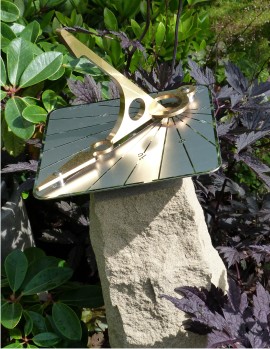Scottish sundial history and modern sundials

The sundial finial at Glamis Castle, Angus, consists of a stone ‘pineapple’ with 80 sundial facets.
Sundials in Scotland have a special history that is quite distinctive. Dating from the seventeenth century, wealthy Scottish landowners started commissioning new sundials for the gardens of their homes.
Like their houses, these sundials were constructed from the familiar building material of stone, but unlike in other countries the sundials often had very complex shapes. It seems the architects and stonemasons delighted in creating the most intricate and imaginative combinations of dial facets that they could. And their masters delighted in showing off their fashionable interest in science and mathematics.
Today, Macmillan Hunter salutes the imagination of Scotland’s old sundial makers. Modern materials and methods have now freed the designer to create entirely new ideas for garden sundials. Fashions will always change, but popular interest in trying to understand the science of the cosmos is as strong as ever. A beautiful new sundial in a garden is a fascinating object.
The fascination of sundials
 A SUNDIAL is not just a garden ornament; it is the culmination of more than 3,000 years of man’s questing to unravel the mysteries of time and the forces that govern our world. A Macmillan Hunter bespoke garden sundial is both a precision instrument and a work of contemporary sculpture.
A SUNDIAL is not just a garden ornament; it is the culmination of more than 3,000 years of man’s questing to unravel the mysteries of time and the forces that govern our world. A Macmillan Hunter bespoke garden sundial is both a precision instrument and a work of contemporary sculpture.
Owning a sundial in your garden
A SUNDIAL allows for meditation on the fleeting yet eternal nature of time. It invites you to chart the progress of the sun and seasons whilst reflecting on your own memorable hours. Reading the dial regularly creates a point of stillness amidst the hectic rush of life.
Sundial styles
Sundials come in a surprising variety of designs, although all are governed by the same mathematical principles. Our garden sundial designs are strikingly modern and include three distinct styles.
VERTICAL From the 17th century vertical dials began to be used as public timepieces, appearing on towers and churches. A vertical dial must be placed in sunshine and aligned to the sun.
HORIZONTAL Once set to the correct alignment, the gnomon on a horizontal sundial in a garden will measure time from hour to hour as the earth spins on its polar axis.
UNIVERSAL The universal sundial has a mechanism that allows the gnomon to be adjusted in line with the earth’s axis at different latitudes in the world.
